Business Strategy Report: Macro and Internal Analysis of Tesco PLC
VerifiedAdded on 2020/05/04
|18
|4579
|62
Report
AI Summary
This report provides a comprehensive analysis of Tesco PLC's business strategy. It begins with an introduction outlining the report's focus on strategic management within Tesco's context. Task 1 employs PESTLE analysis to examine the macro environment, assessing political, economic, social, technological, legal, and environmental factors impacting Tesco's operations and strategic decisions. Task 2 delves into the internal environment, utilizing SWOT analysis to identify strengths, weaknesses, opportunities, and threats. The analysis further examines Tesco's internal capabilities, structure, and skill set. Task 3 applies Porter's Five Forces to assess the competitive landscape, followed by a discussion of appropriate strategies for achieving competitive advantages and market positioning. Finally, Task 4 explores relevant theories, concepts, and models for managing strategic directions, culminating in an interpretation of a proper strategic management plan for Tesco PLC. The report concludes with a summary of findings and recommendations.
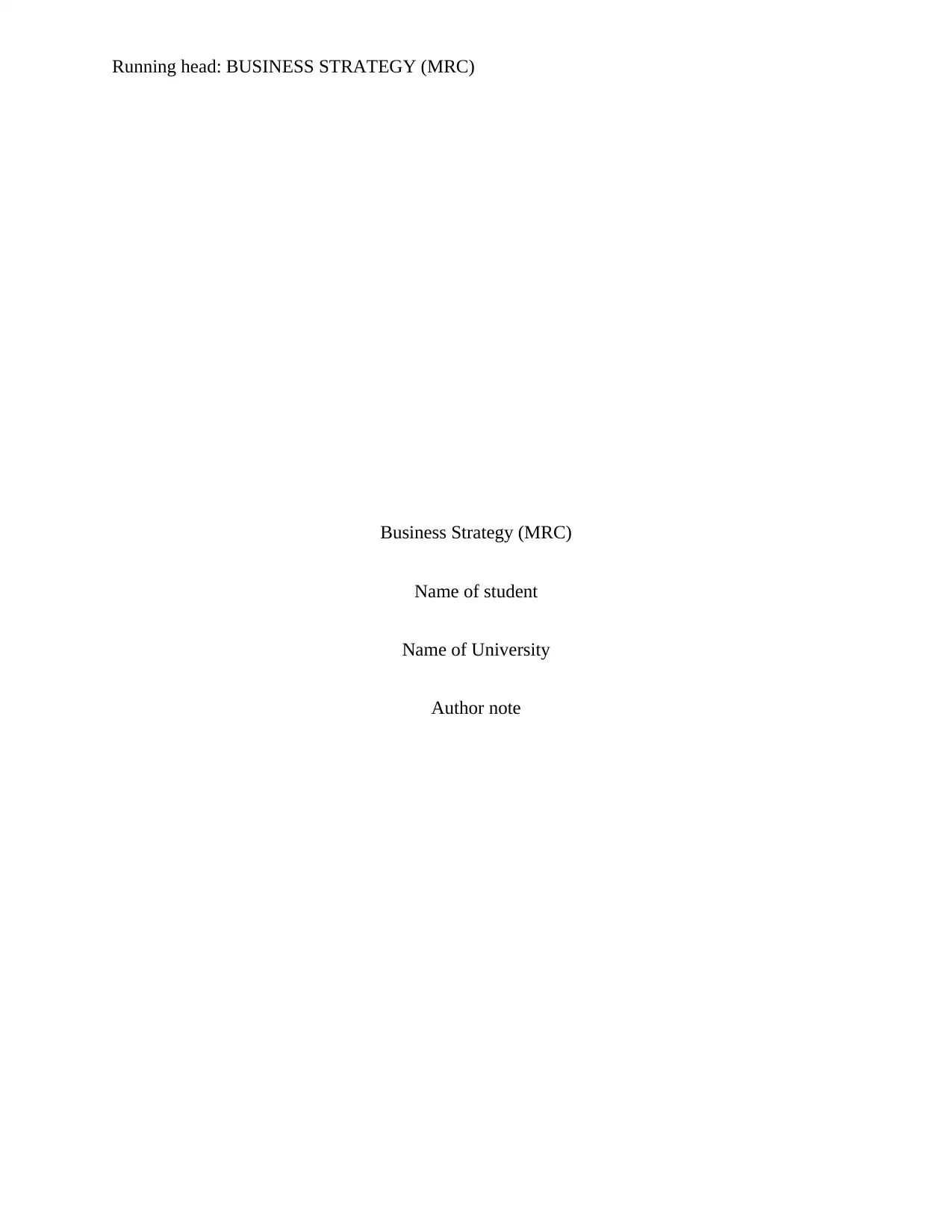
Running head: BUSINESS STRATEGY (MRC)
Business Strategy (MRC)
Name of student
Name of University
Author note
Business Strategy (MRC)
Name of student
Name of University
Author note
Paraphrase This Document
Need a fresh take? Get an instant paraphrase of this document with our AI Paraphraser
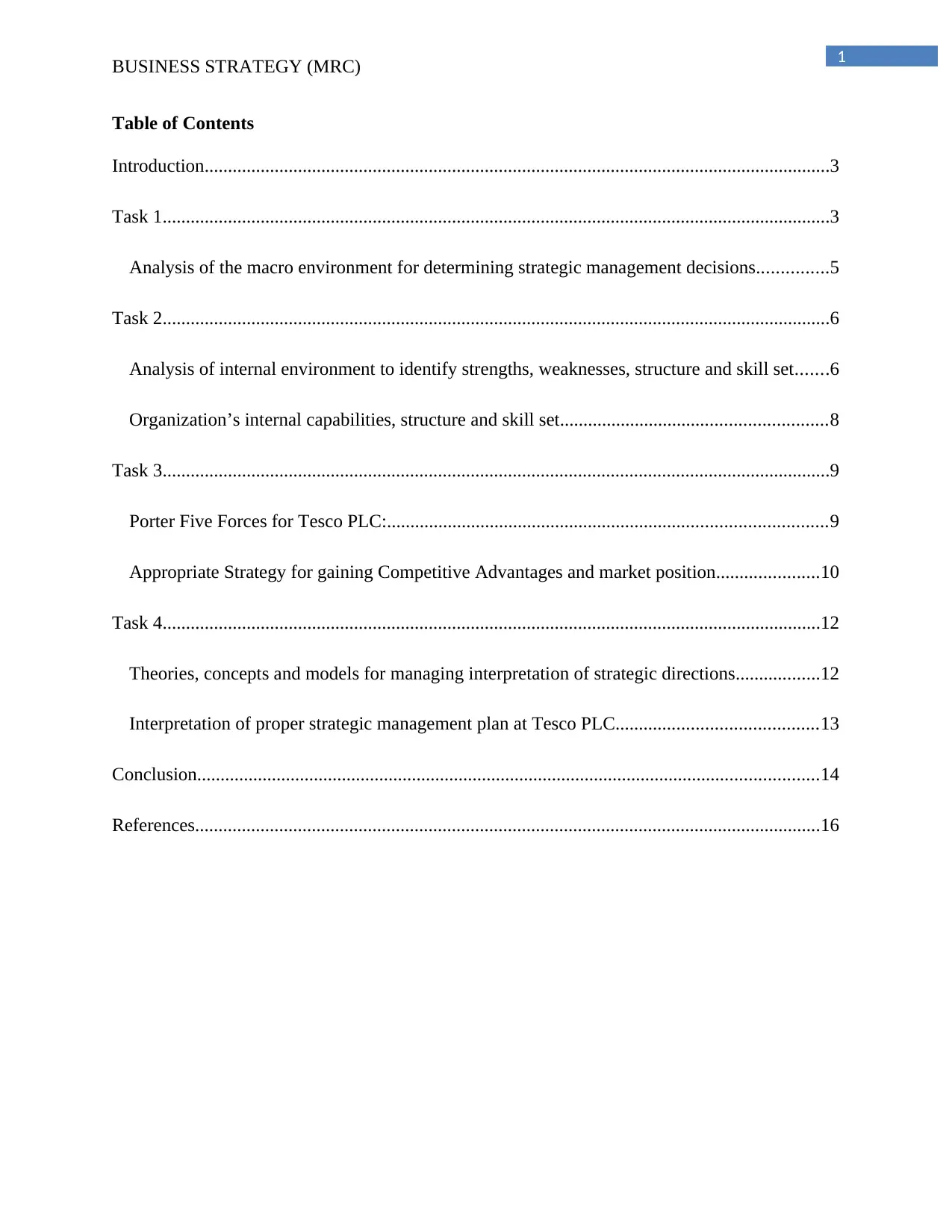
1
BUSINESS STRATEGY (MRC)
Table of Contents
Introduction......................................................................................................................................3
Task 1...............................................................................................................................................3
Analysis of the macro environment for determining strategic management decisions...............5
Task 2...............................................................................................................................................6
Analysis of internal environment to identify strengths, weaknesses, structure and skill set.......6
Organization’s internal capabilities, structure and skill set.........................................................8
Task 3...............................................................................................................................................9
Porter Five Forces for Tesco PLC:..............................................................................................9
Appropriate Strategy for gaining Competitive Advantages and market position......................10
Task 4.............................................................................................................................................12
Theories, concepts and models for managing interpretation of strategic directions..................12
Interpretation of proper strategic management plan at Tesco PLC...........................................13
Conclusion.....................................................................................................................................14
References......................................................................................................................................16
BUSINESS STRATEGY (MRC)
Table of Contents
Introduction......................................................................................................................................3
Task 1...............................................................................................................................................3
Analysis of the macro environment for determining strategic management decisions...............5
Task 2...............................................................................................................................................6
Analysis of internal environment to identify strengths, weaknesses, structure and skill set.......6
Organization’s internal capabilities, structure and skill set.........................................................8
Task 3...............................................................................................................................................9
Porter Five Forces for Tesco PLC:..............................................................................................9
Appropriate Strategy for gaining Competitive Advantages and market position......................10
Task 4.............................................................................................................................................12
Theories, concepts and models for managing interpretation of strategic directions..................12
Interpretation of proper strategic management plan at Tesco PLC...........................................13
Conclusion.....................................................................................................................................14
References......................................................................................................................................16
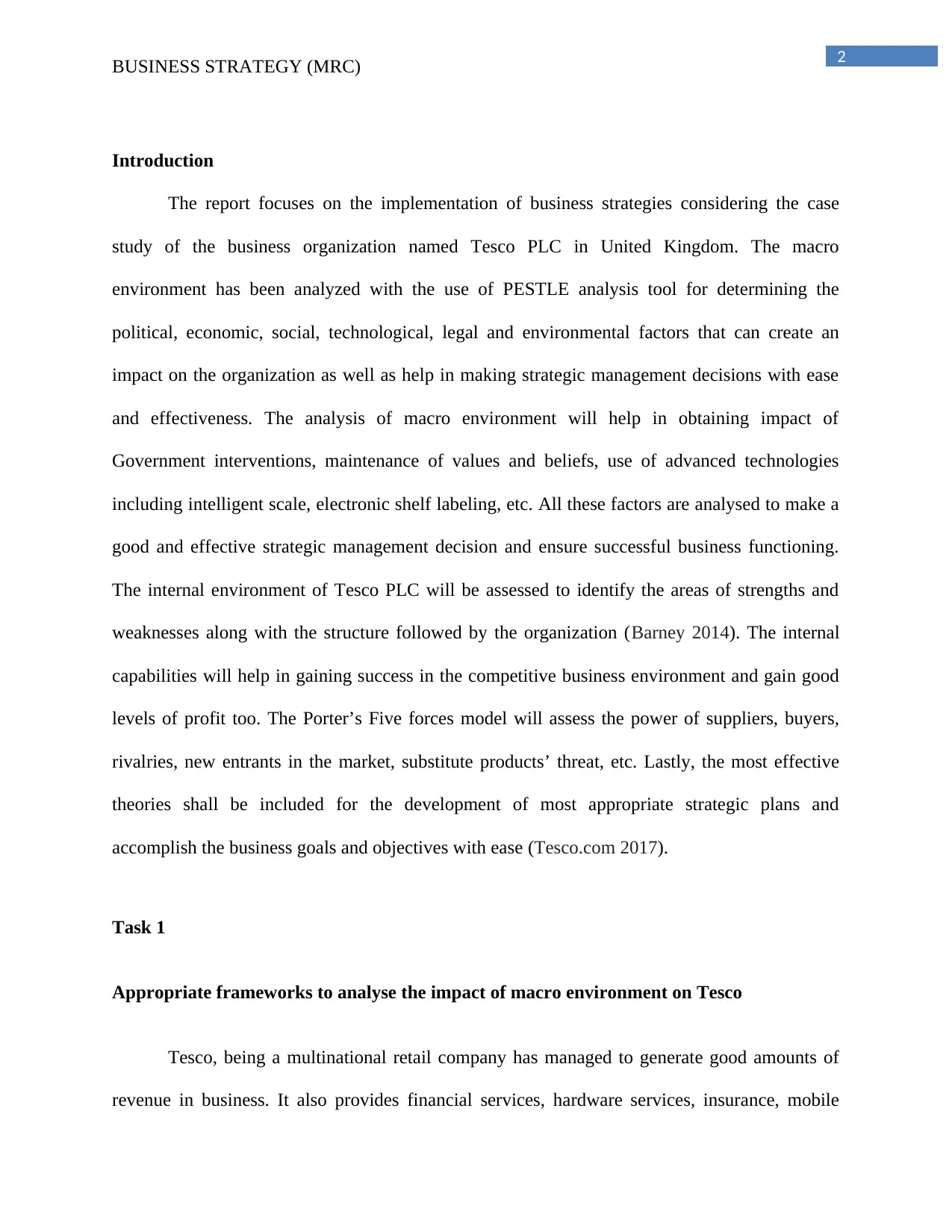
2
BUSINESS STRATEGY (MRC)
Introduction
The report focuses on the implementation of business strategies considering the case
study of the business organization named Tesco PLC in United Kingdom. The macro
environment has been analyzed with the use of PESTLE analysis tool for determining the
political, economic, social, technological, legal and environmental factors that can create an
impact on the organization as well as help in making strategic management decisions with ease
and effectiveness. The analysis of macro environment will help in obtaining impact of
Government interventions, maintenance of values and beliefs, use of advanced technologies
including intelligent scale, electronic shelf labeling, etc. All these factors are analysed to make a
good and effective strategic management decision and ensure successful business functioning.
The internal environment of Tesco PLC will be assessed to identify the areas of strengths and
weaknesses along with the structure followed by the organization (Barney 2014). The internal
capabilities will help in gaining success in the competitive business environment and gain good
levels of profit too. The Porter’s Five forces model will assess the power of suppliers, buyers,
rivalries, new entrants in the market, substitute products’ threat, etc. Lastly, the most effective
theories shall be included for the development of most appropriate strategic plans and
accomplish the business goals and objectives with ease (Tesco.com 2017).
Task 1
Appropriate frameworks to analyse the impact of macro environment on Tesco
Tesco, being a multinational retail company has managed to generate good amounts of
revenue in business. It also provides financial services, hardware services, insurance, mobile
BUSINESS STRATEGY (MRC)
Introduction
The report focuses on the implementation of business strategies considering the case
study of the business organization named Tesco PLC in United Kingdom. The macro
environment has been analyzed with the use of PESTLE analysis tool for determining the
political, economic, social, technological, legal and environmental factors that can create an
impact on the organization as well as help in making strategic management decisions with ease
and effectiveness. The analysis of macro environment will help in obtaining impact of
Government interventions, maintenance of values and beliefs, use of advanced technologies
including intelligent scale, electronic shelf labeling, etc. All these factors are analysed to make a
good and effective strategic management decision and ensure successful business functioning.
The internal environment of Tesco PLC will be assessed to identify the areas of strengths and
weaknesses along with the structure followed by the organization (Barney 2014). The internal
capabilities will help in gaining success in the competitive business environment and gain good
levels of profit too. The Porter’s Five forces model will assess the power of suppliers, buyers,
rivalries, new entrants in the market, substitute products’ threat, etc. Lastly, the most effective
theories shall be included for the development of most appropriate strategic plans and
accomplish the business goals and objectives with ease (Tesco.com 2017).
Task 1
Appropriate frameworks to analyse the impact of macro environment on Tesco
Tesco, being a multinational retail company has managed to generate good amounts of
revenue in business. It also provides financial services, hardware services, insurance, mobile
⊘ This is a preview!⊘
Do you want full access?
Subscribe today to unlock all pages.

Trusted by 1+ million students worldwide
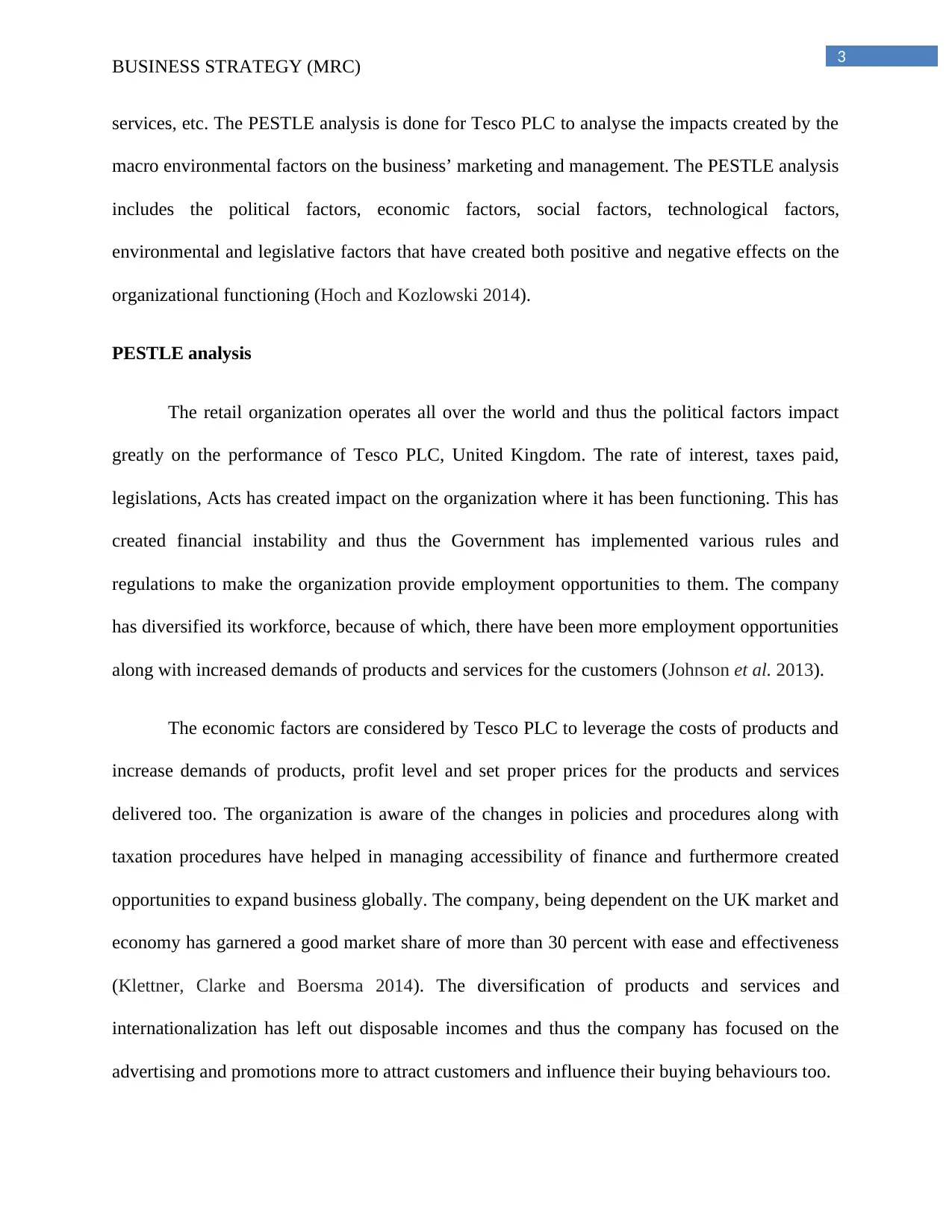
3
BUSINESS STRATEGY (MRC)
services, etc. The PESTLE analysis is done for Tesco PLC to analyse the impacts created by the
macro environmental factors on the business’ marketing and management. The PESTLE analysis
includes the political factors, economic factors, social factors, technological factors,
environmental and legislative factors that have created both positive and negative effects on the
organizational functioning (Hoch and Kozlowski 2014).
PESTLE analysis
The retail organization operates all over the world and thus the political factors impact
greatly on the performance of Tesco PLC, United Kingdom. The rate of interest, taxes paid,
legislations, Acts has created impact on the organization where it has been functioning. This has
created financial instability and thus the Government has implemented various rules and
regulations to make the organization provide employment opportunities to them. The company
has diversified its workforce, because of which, there have been more employment opportunities
along with increased demands of products and services for the customers (Johnson et al. 2013).
The economic factors are considered by Tesco PLC to leverage the costs of products and
increase demands of products, profit level and set proper prices for the products and services
delivered too. The organization is aware of the changes in policies and procedures along with
taxation procedures have helped in managing accessibility of finance and furthermore created
opportunities to expand business globally. The company, being dependent on the UK market and
economy has garnered a good market share of more than 30 percent with ease and effectiveness
(Klettner, Clarke and Boersma 2014). The diversification of products and services and
internationalization has left out disposable incomes and thus the company has focused on the
advertising and promotions more to attract customers and influence their buying behaviours too.
BUSINESS STRATEGY (MRC)
services, etc. The PESTLE analysis is done for Tesco PLC to analyse the impacts created by the
macro environmental factors on the business’ marketing and management. The PESTLE analysis
includes the political factors, economic factors, social factors, technological factors,
environmental and legislative factors that have created both positive and negative effects on the
organizational functioning (Hoch and Kozlowski 2014).
PESTLE analysis
The retail organization operates all over the world and thus the political factors impact
greatly on the performance of Tesco PLC, United Kingdom. The rate of interest, taxes paid,
legislations, Acts has created impact on the organization where it has been functioning. This has
created financial instability and thus the Government has implemented various rules and
regulations to make the organization provide employment opportunities to them. The company
has diversified its workforce, because of which, there have been more employment opportunities
along with increased demands of products and services for the customers (Johnson et al. 2013).
The economic factors are considered by Tesco PLC to leverage the costs of products and
increase demands of products, profit level and set proper prices for the products and services
delivered too. The organization is aware of the changes in policies and procedures along with
taxation procedures have helped in managing accessibility of finance and furthermore created
opportunities to expand business globally. The company, being dependent on the UK market and
economy has garnered a good market share of more than 30 percent with ease and effectiveness
(Klettner, Clarke and Boersma 2014). The diversification of products and services and
internationalization has left out disposable incomes and thus the company has focused on the
advertising and promotions more to attract customers and influence their buying behaviours too.
Paraphrase This Document
Need a fresh take? Get an instant paraphrase of this document with our AI Paraphraser
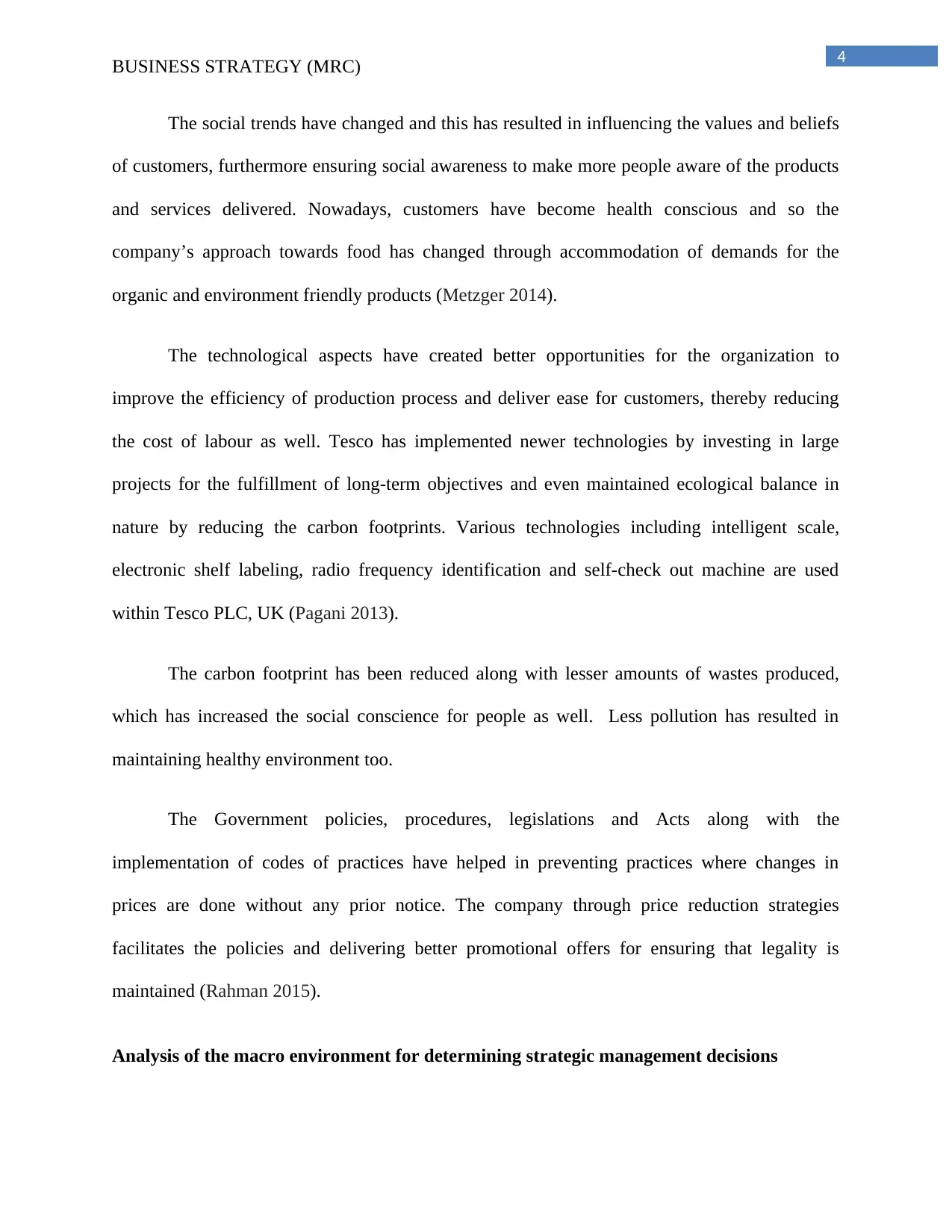
4
BUSINESS STRATEGY (MRC)
The social trends have changed and this has resulted in influencing the values and beliefs
of customers, furthermore ensuring social awareness to make more people aware of the products
and services delivered. Nowadays, customers have become health conscious and so the
company’s approach towards food has changed through accommodation of demands for the
organic and environment friendly products (Metzger 2014).
The technological aspects have created better opportunities for the organization to
improve the efficiency of production process and deliver ease for customers, thereby reducing
the cost of labour as well. Tesco has implemented newer technologies by investing in large
projects for the fulfillment of long-term objectives and even maintained ecological balance in
nature by reducing the carbon footprints. Various technologies including intelligent scale,
electronic shelf labeling, radio frequency identification and self-check out machine are used
within Tesco PLC, UK (Pagani 2013).
The carbon footprint has been reduced along with lesser amounts of wastes produced,
which has increased the social conscience for people as well. Less pollution has resulted in
maintaining healthy environment too.
The Government policies, procedures, legislations and Acts along with the
implementation of codes of practices have helped in preventing practices where changes in
prices are done without any prior notice. The company through price reduction strategies
facilitates the policies and delivering better promotional offers for ensuring that legality is
maintained (Rahman 2015).
Analysis of the macro environment for determining strategic management decisions
BUSINESS STRATEGY (MRC)
The social trends have changed and this has resulted in influencing the values and beliefs
of customers, furthermore ensuring social awareness to make more people aware of the products
and services delivered. Nowadays, customers have become health conscious and so the
company’s approach towards food has changed through accommodation of demands for the
organic and environment friendly products (Metzger 2014).
The technological aspects have created better opportunities for the organization to
improve the efficiency of production process and deliver ease for customers, thereby reducing
the cost of labour as well. Tesco has implemented newer technologies by investing in large
projects for the fulfillment of long-term objectives and even maintained ecological balance in
nature by reducing the carbon footprints. Various technologies including intelligent scale,
electronic shelf labeling, radio frequency identification and self-check out machine are used
within Tesco PLC, UK (Pagani 2013).
The carbon footprint has been reduced along with lesser amounts of wastes produced,
which has increased the social conscience for people as well. Less pollution has resulted in
maintaining healthy environment too.
The Government policies, procedures, legislations and Acts along with the
implementation of codes of practices have helped in preventing practices where changes in
prices are done without any prior notice. The company through price reduction strategies
facilitates the policies and delivering better promotional offers for ensuring that legality is
maintained (Rahman 2015).
Analysis of the macro environment for determining strategic management decisions
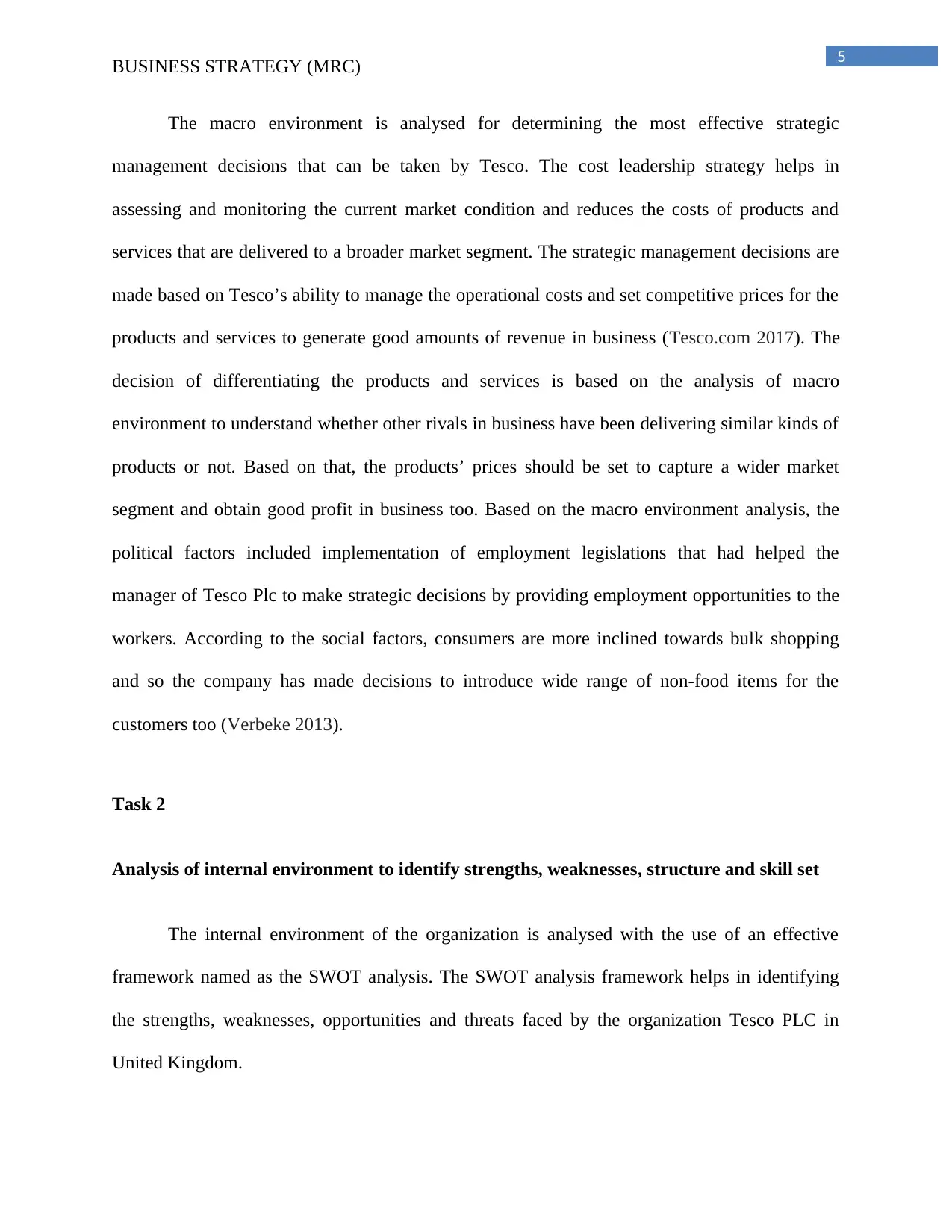
5
BUSINESS STRATEGY (MRC)
The macro environment is analysed for determining the most effective strategic
management decisions that can be taken by Tesco. The cost leadership strategy helps in
assessing and monitoring the current market condition and reduces the costs of products and
services that are delivered to a broader market segment. The strategic management decisions are
made based on Tesco’s ability to manage the operational costs and set competitive prices for the
products and services to generate good amounts of revenue in business (Tesco.com 2017). The
decision of differentiating the products and services is based on the analysis of macro
environment to understand whether other rivals in business have been delivering similar kinds of
products or not. Based on that, the products’ prices should be set to capture a wider market
segment and obtain good profit in business too. Based on the macro environment analysis, the
political factors included implementation of employment legislations that had helped the
manager of Tesco Plc to make strategic decisions by providing employment opportunities to the
workers. According to the social factors, consumers are more inclined towards bulk shopping
and so the company has made decisions to introduce wide range of non-food items for the
customers too (Verbeke 2013).
Task 2
Analysis of internal environment to identify strengths, weaknesses, structure and skill set
The internal environment of the organization is analysed with the use of an effective
framework named as the SWOT analysis. The SWOT analysis framework helps in identifying
the strengths, weaknesses, opportunities and threats faced by the organization Tesco PLC in
United Kingdom.
BUSINESS STRATEGY (MRC)
The macro environment is analysed for determining the most effective strategic
management decisions that can be taken by Tesco. The cost leadership strategy helps in
assessing and monitoring the current market condition and reduces the costs of products and
services that are delivered to a broader market segment. The strategic management decisions are
made based on Tesco’s ability to manage the operational costs and set competitive prices for the
products and services to generate good amounts of revenue in business (Tesco.com 2017). The
decision of differentiating the products and services is based on the analysis of macro
environment to understand whether other rivals in business have been delivering similar kinds of
products or not. Based on that, the products’ prices should be set to capture a wider market
segment and obtain good profit in business too. Based on the macro environment analysis, the
political factors included implementation of employment legislations that had helped the
manager of Tesco Plc to make strategic decisions by providing employment opportunities to the
workers. According to the social factors, consumers are more inclined towards bulk shopping
and so the company has made decisions to introduce wide range of non-food items for the
customers too (Verbeke 2013).
Task 2
Analysis of internal environment to identify strengths, weaknesses, structure and skill set
The internal environment of the organization is analysed with the use of an effective
framework named as the SWOT analysis. The SWOT analysis framework helps in identifying
the strengths, weaknesses, opportunities and threats faced by the organization Tesco PLC in
United Kingdom.
⊘ This is a preview!⊘
Do you want full access?
Subscribe today to unlock all pages.

Trusted by 1+ million students worldwide
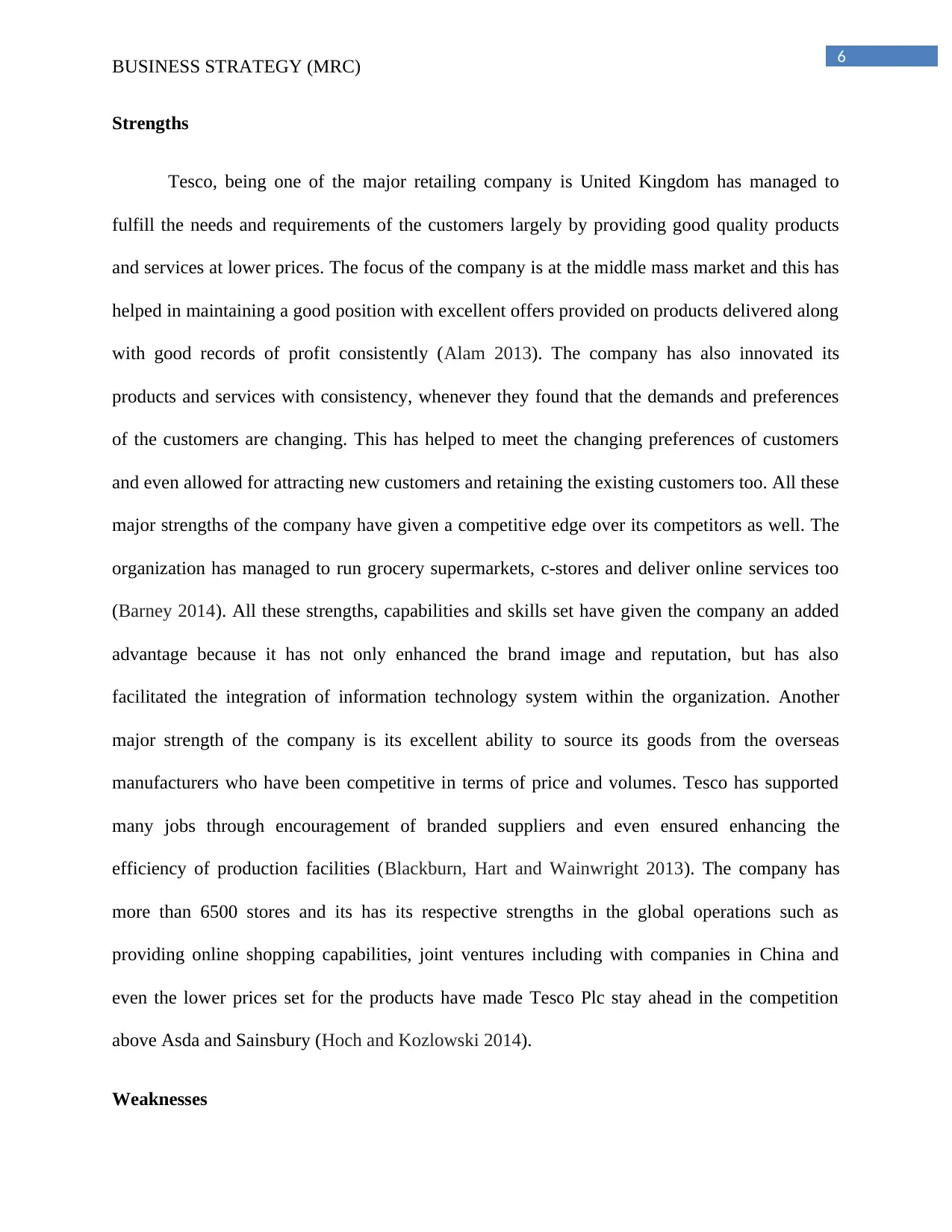
6
BUSINESS STRATEGY (MRC)
Strengths
Tesco, being one of the major retailing company is United Kingdom has managed to
fulfill the needs and requirements of the customers largely by providing good quality products
and services at lower prices. The focus of the company is at the middle mass market and this has
helped in maintaining a good position with excellent offers provided on products delivered along
with good records of profit consistently (Alam 2013). The company has also innovated its
products and services with consistency, whenever they found that the demands and preferences
of the customers are changing. This has helped to meet the changing preferences of customers
and even allowed for attracting new customers and retaining the existing customers too. All these
major strengths of the company have given a competitive edge over its competitors as well. The
organization has managed to run grocery supermarkets, c-stores and deliver online services too
(Barney 2014). All these strengths, capabilities and skills set have given the company an added
advantage because it has not only enhanced the brand image and reputation, but has also
facilitated the integration of information technology system within the organization. Another
major strength of the company is its excellent ability to source its goods from the overseas
manufacturers who have been competitive in terms of price and volumes. Tesco has supported
many jobs through encouragement of branded suppliers and even ensured enhancing the
efficiency of production facilities (Blackburn, Hart and Wainwright 2013). The company has
more than 6500 stores and its has its respective strengths in the global operations such as
providing online shopping capabilities, joint ventures including with companies in China and
even the lower prices set for the products have made Tesco Plc stay ahead in the competition
above Asda and Sainsbury (Hoch and Kozlowski 2014).
Weaknesses
BUSINESS STRATEGY (MRC)
Strengths
Tesco, being one of the major retailing company is United Kingdom has managed to
fulfill the needs and requirements of the customers largely by providing good quality products
and services at lower prices. The focus of the company is at the middle mass market and this has
helped in maintaining a good position with excellent offers provided on products delivered along
with good records of profit consistently (Alam 2013). The company has also innovated its
products and services with consistency, whenever they found that the demands and preferences
of the customers are changing. This has helped to meet the changing preferences of customers
and even allowed for attracting new customers and retaining the existing customers too. All these
major strengths of the company have given a competitive edge over its competitors as well. The
organization has managed to run grocery supermarkets, c-stores and deliver online services too
(Barney 2014). All these strengths, capabilities and skills set have given the company an added
advantage because it has not only enhanced the brand image and reputation, but has also
facilitated the integration of information technology system within the organization. Another
major strength of the company is its excellent ability to source its goods from the overseas
manufacturers who have been competitive in terms of price and volumes. Tesco has supported
many jobs through encouragement of branded suppliers and even ensured enhancing the
efficiency of production facilities (Blackburn, Hart and Wainwright 2013). The company has
more than 6500 stores and its has its respective strengths in the global operations such as
providing online shopping capabilities, joint ventures including with companies in China and
even the lower prices set for the products have made Tesco Plc stay ahead in the competition
above Asda and Sainsbury (Hoch and Kozlowski 2014).
Weaknesses
Paraphrase This Document
Need a fresh take? Get an instant paraphrase of this document with our AI Paraphraser
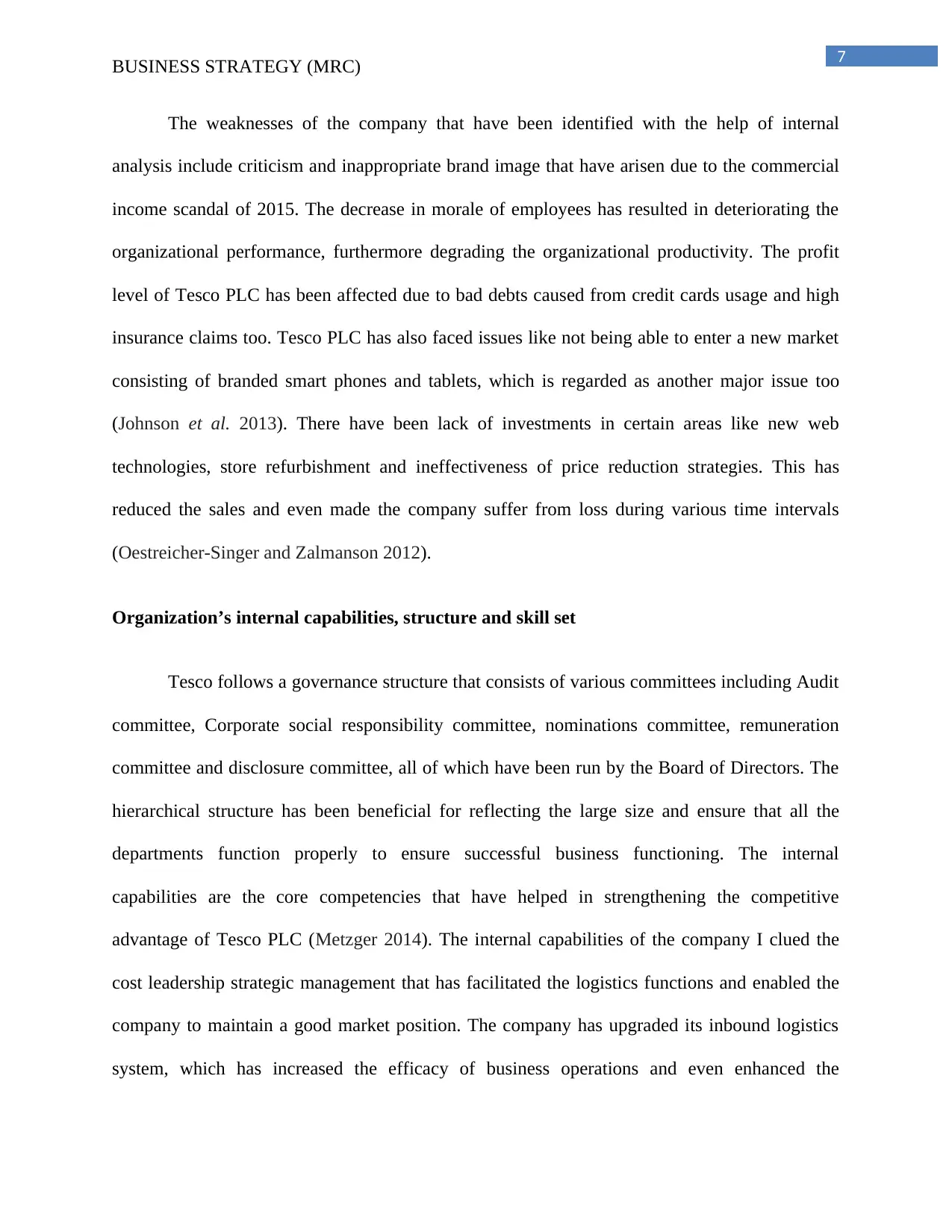
7
BUSINESS STRATEGY (MRC)
The weaknesses of the company that have been identified with the help of internal
analysis include criticism and inappropriate brand image that have arisen due to the commercial
income scandal of 2015. The decrease in morale of employees has resulted in deteriorating the
organizational performance, furthermore degrading the organizational productivity. The profit
level of Tesco PLC has been affected due to bad debts caused from credit cards usage and high
insurance claims too. Tesco PLC has also faced issues like not being able to enter a new market
consisting of branded smart phones and tablets, which is regarded as another major issue too
(Johnson et al. 2013). There have been lack of investments in certain areas like new web
technologies, store refurbishment and ineffectiveness of price reduction strategies. This has
reduced the sales and even made the company suffer from loss during various time intervals
(Oestreicher-Singer and Zalmanson 2012).
Organization’s internal capabilities, structure and skill set
Tesco follows a governance structure that consists of various committees including Audit
committee, Corporate social responsibility committee, nominations committee, remuneration
committee and disclosure committee, all of which have been run by the Board of Directors. The
hierarchical structure has been beneficial for reflecting the large size and ensure that all the
departments function properly to ensure successful business functioning. The internal
capabilities are the core competencies that have helped in strengthening the competitive
advantage of Tesco PLC (Metzger 2014). The internal capabilities of the company I clued the
cost leadership strategic management that has facilitated the logistics functions and enabled the
company to maintain a good market position. The company has upgraded its inbound logistics
system, which has increased the efficacy of business operations and even enhanced the
BUSINESS STRATEGY (MRC)
The weaknesses of the company that have been identified with the help of internal
analysis include criticism and inappropriate brand image that have arisen due to the commercial
income scandal of 2015. The decrease in morale of employees has resulted in deteriorating the
organizational performance, furthermore degrading the organizational productivity. The profit
level of Tesco PLC has been affected due to bad debts caused from credit cards usage and high
insurance claims too. Tesco PLC has also faced issues like not being able to enter a new market
consisting of branded smart phones and tablets, which is regarded as another major issue too
(Johnson et al. 2013). There have been lack of investments in certain areas like new web
technologies, store refurbishment and ineffectiveness of price reduction strategies. This has
reduced the sales and even made the company suffer from loss during various time intervals
(Oestreicher-Singer and Zalmanson 2012).
Organization’s internal capabilities, structure and skill set
Tesco follows a governance structure that consists of various committees including Audit
committee, Corporate social responsibility committee, nominations committee, remuneration
committee and disclosure committee, all of which have been run by the Board of Directors. The
hierarchical structure has been beneficial for reflecting the large size and ensure that all the
departments function properly to ensure successful business functioning. The internal
capabilities are the core competencies that have helped in strengthening the competitive
advantage of Tesco PLC (Metzger 2014). The internal capabilities of the company I clued the
cost leadership strategic management that has facilitated the logistics functions and enabled the
company to maintain a good market position. The company has upgraded its inbound logistics
system, which has increased the efficacy of business operations and even enhanced the
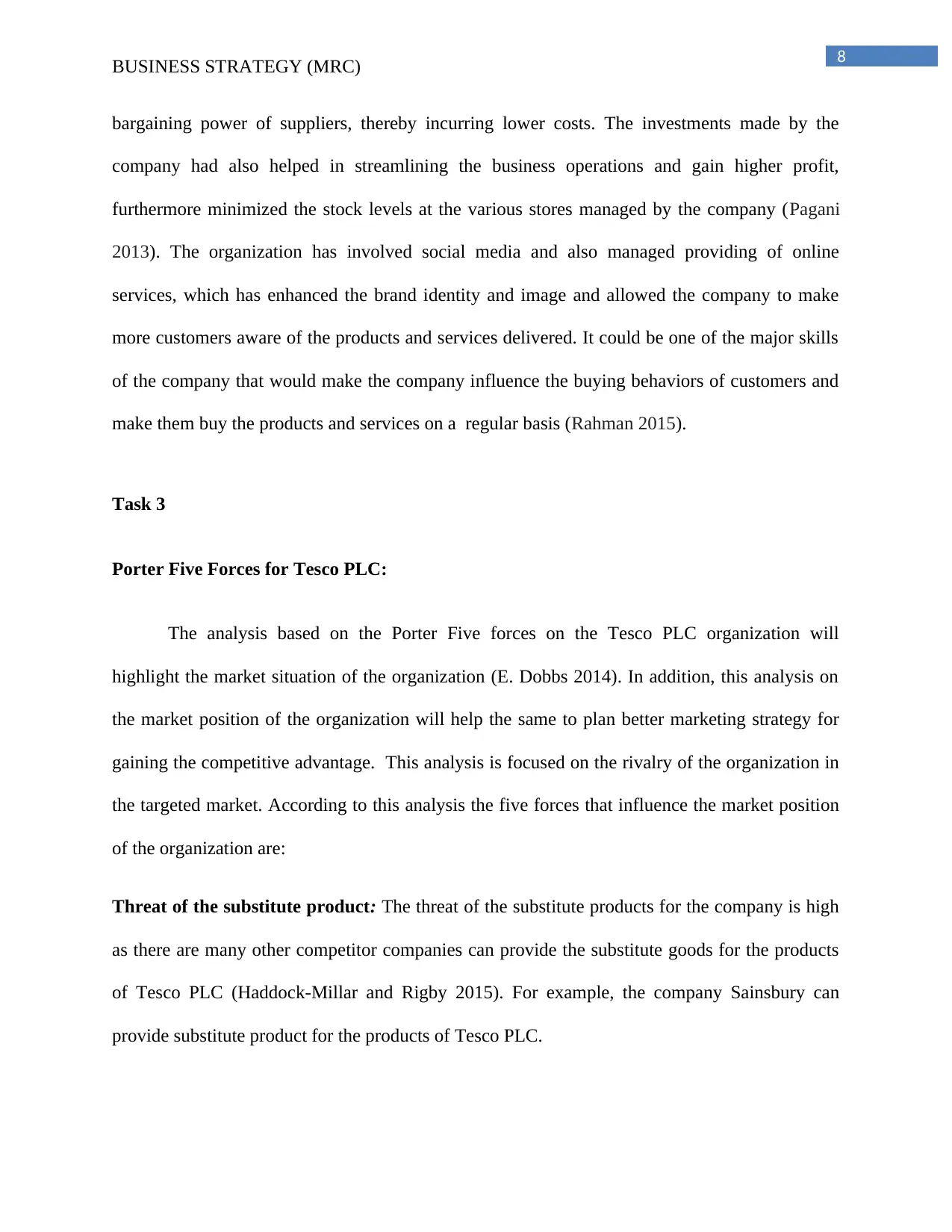
8
BUSINESS STRATEGY (MRC)
bargaining power of suppliers, thereby incurring lower costs. The investments made by the
company had also helped in streamlining the business operations and gain higher profit,
furthermore minimized the stock levels at the various stores managed by the company (Pagani
2013). The organization has involved social media and also managed providing of online
services, which has enhanced the brand identity and image and allowed the company to make
more customers aware of the products and services delivered. It could be one of the major skills
of the company that would make the company influence the buying behaviors of customers and
make them buy the products and services on a regular basis (Rahman 2015).
Task 3
Porter Five Forces for Tesco PLC:
The analysis based on the Porter Five forces on the Tesco PLC organization will
highlight the market situation of the organization (E. Dobbs 2014). In addition, this analysis on
the market position of the organization will help the same to plan better marketing strategy for
gaining the competitive advantage. This analysis is focused on the rivalry of the organization in
the targeted market. According to this analysis the five forces that influence the market position
of the organization are:
Threat of the substitute product: The threat of the substitute products for the company is high
as there are many other competitor companies can provide the substitute goods for the products
of Tesco PLC (Haddock-Millar and Rigby 2015). For example, the company Sainsbury can
provide substitute product for the products of Tesco PLC.
BUSINESS STRATEGY (MRC)
bargaining power of suppliers, thereby incurring lower costs. The investments made by the
company had also helped in streamlining the business operations and gain higher profit,
furthermore minimized the stock levels at the various stores managed by the company (Pagani
2013). The organization has involved social media and also managed providing of online
services, which has enhanced the brand identity and image and allowed the company to make
more customers aware of the products and services delivered. It could be one of the major skills
of the company that would make the company influence the buying behaviors of customers and
make them buy the products and services on a regular basis (Rahman 2015).
Task 3
Porter Five Forces for Tesco PLC:
The analysis based on the Porter Five forces on the Tesco PLC organization will
highlight the market situation of the organization (E. Dobbs 2014). In addition, this analysis on
the market position of the organization will help the same to plan better marketing strategy for
gaining the competitive advantage. This analysis is focused on the rivalry of the organization in
the targeted market. According to this analysis the five forces that influence the market position
of the organization are:
Threat of the substitute product: The threat of the substitute products for the company is high
as there are many other competitor companies can provide the substitute goods for the products
of Tesco PLC (Haddock-Millar and Rigby 2015). For example, the company Sainsbury can
provide substitute product for the products of Tesco PLC.
⊘ This is a preview!⊘
Do you want full access?
Subscribe today to unlock all pages.

Trusted by 1+ million students worldwide
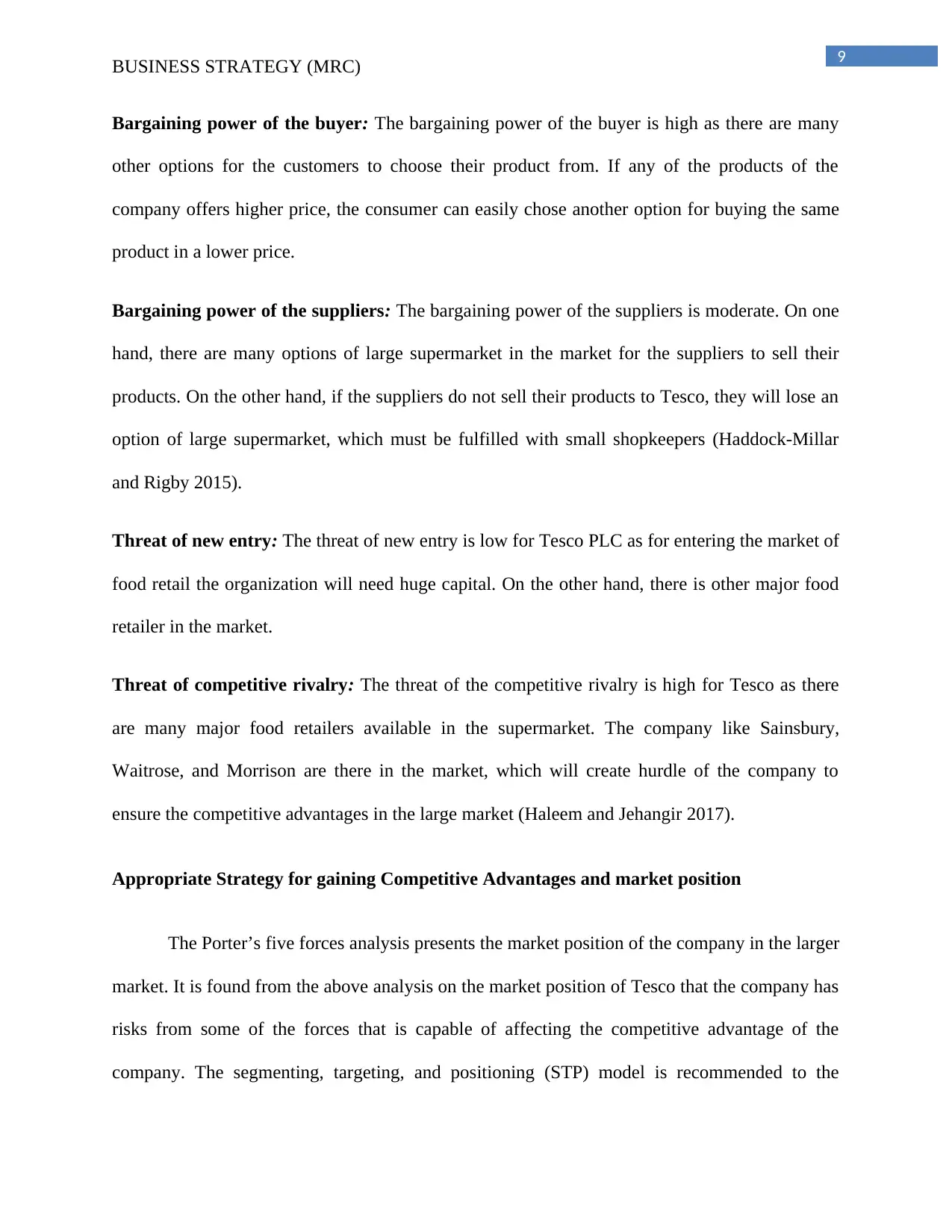
9
BUSINESS STRATEGY (MRC)
Bargaining power of the buyer: The bargaining power of the buyer is high as there are many
other options for the customers to choose their product from. If any of the products of the
company offers higher price, the consumer can easily chose another option for buying the same
product in a lower price.
Bargaining power of the suppliers: The bargaining power of the suppliers is moderate. On one
hand, there are many options of large supermarket in the market for the suppliers to sell their
products. On the other hand, if the suppliers do not sell their products to Tesco, they will lose an
option of large supermarket, which must be fulfilled with small shopkeepers (Haddock-Millar
and Rigby 2015).
Threat of new entry: The threat of new entry is low for Tesco PLC as for entering the market of
food retail the organization will need huge capital. On the other hand, there is other major food
retailer in the market.
Threat of competitive rivalry: The threat of the competitive rivalry is high for Tesco as there
are many major food retailers available in the supermarket. The company like Sainsbury,
Waitrose, and Morrison are there in the market, which will create hurdle of the company to
ensure the competitive advantages in the large market (Haleem and Jehangir 2017).
Appropriate Strategy for gaining Competitive Advantages and market position
The Porter’s five forces analysis presents the market position of the company in the larger
market. It is found from the above analysis on the market position of Tesco that the company has
risks from some of the forces that is capable of affecting the competitive advantage of the
company. The segmenting, targeting, and positioning (STP) model is recommended to the
BUSINESS STRATEGY (MRC)
Bargaining power of the buyer: The bargaining power of the buyer is high as there are many
other options for the customers to choose their product from. If any of the products of the
company offers higher price, the consumer can easily chose another option for buying the same
product in a lower price.
Bargaining power of the suppliers: The bargaining power of the suppliers is moderate. On one
hand, there are many options of large supermarket in the market for the suppliers to sell their
products. On the other hand, if the suppliers do not sell their products to Tesco, they will lose an
option of large supermarket, which must be fulfilled with small shopkeepers (Haddock-Millar
and Rigby 2015).
Threat of new entry: The threat of new entry is low for Tesco PLC as for entering the market of
food retail the organization will need huge capital. On the other hand, there is other major food
retailer in the market.
Threat of competitive rivalry: The threat of the competitive rivalry is high for Tesco as there
are many major food retailers available in the supermarket. The company like Sainsbury,
Waitrose, and Morrison are there in the market, which will create hurdle of the company to
ensure the competitive advantages in the large market (Haleem and Jehangir 2017).
Appropriate Strategy for gaining Competitive Advantages and market position
The Porter’s five forces analysis presents the market position of the company in the larger
market. It is found from the above analysis on the market position of Tesco that the company has
risks from some of the forces that is capable of affecting the competitive advantage of the
company. The segmenting, targeting, and positioning (STP) model is recommended to the
Paraphrase This Document
Need a fresh take? Get an instant paraphrase of this document with our AI Paraphraser
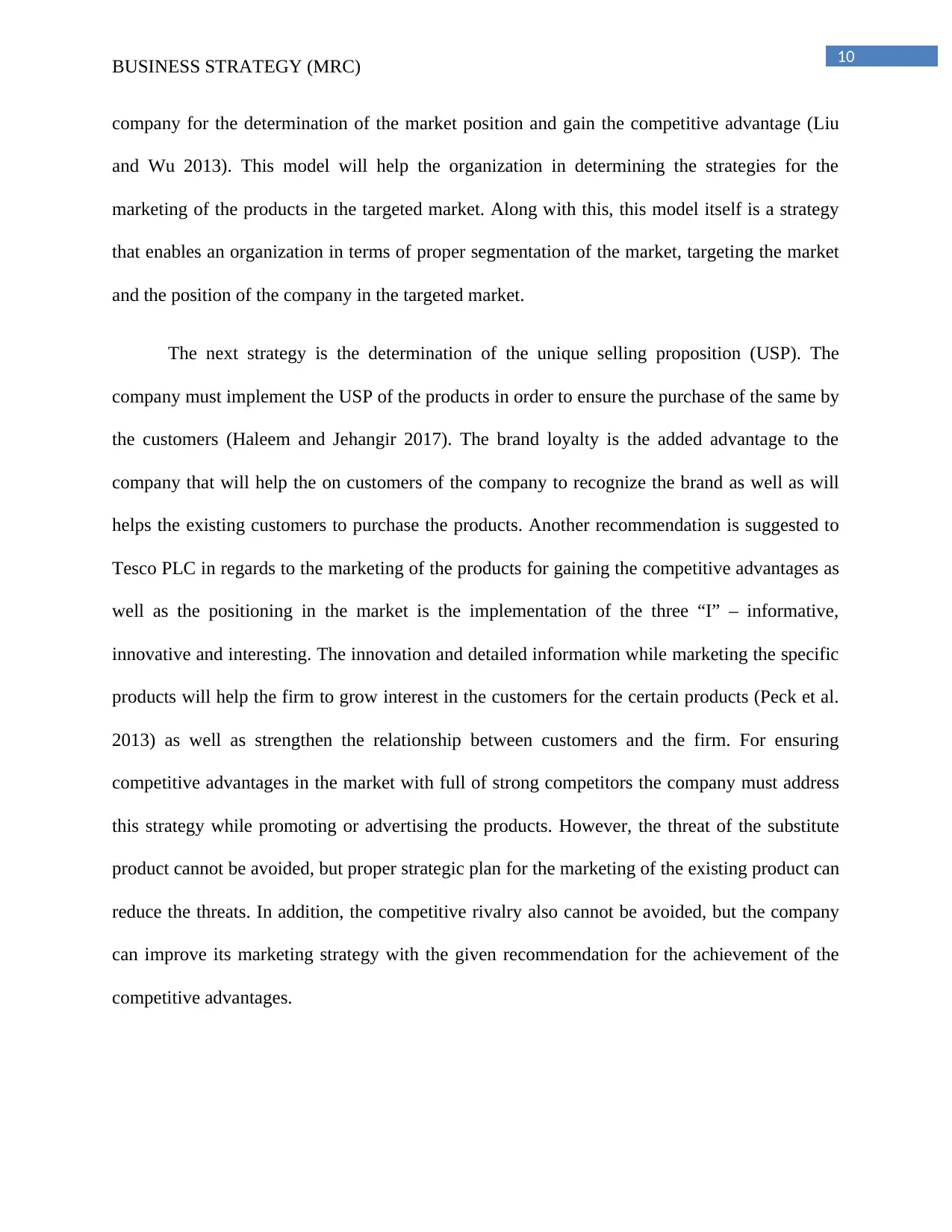
10
BUSINESS STRATEGY (MRC)
company for the determination of the market position and gain the competitive advantage (Liu
and Wu 2013). This model will help the organization in determining the strategies for the
marketing of the products in the targeted market. Along with this, this model itself is a strategy
that enables an organization in terms of proper segmentation of the market, targeting the market
and the position of the company in the targeted market.
The next strategy is the determination of the unique selling proposition (USP). The
company must implement the USP of the products in order to ensure the purchase of the same by
the customers (Haleem and Jehangir 2017). The brand loyalty is the added advantage to the
company that will help the on customers of the company to recognize the brand as well as will
helps the existing customers to purchase the products. Another recommendation is suggested to
Tesco PLC in regards to the marketing of the products for gaining the competitive advantages as
well as the positioning in the market is the implementation of the three “I” – informative,
innovative and interesting. The innovation and detailed information while marketing the specific
products will help the firm to grow interest in the customers for the certain products (Peck et al.
2013) as well as strengthen the relationship between customers and the firm. For ensuring
competitive advantages in the market with full of strong competitors the company must address
this strategy while promoting or advertising the products. However, the threat of the substitute
product cannot be avoided, but proper strategic plan for the marketing of the existing product can
reduce the threats. In addition, the competitive rivalry also cannot be avoided, but the company
can improve its marketing strategy with the given recommendation for the achievement of the
competitive advantages.
BUSINESS STRATEGY (MRC)
company for the determination of the market position and gain the competitive advantage (Liu
and Wu 2013). This model will help the organization in determining the strategies for the
marketing of the products in the targeted market. Along with this, this model itself is a strategy
that enables an organization in terms of proper segmentation of the market, targeting the market
and the position of the company in the targeted market.
The next strategy is the determination of the unique selling proposition (USP). The
company must implement the USP of the products in order to ensure the purchase of the same by
the customers (Haleem and Jehangir 2017). The brand loyalty is the added advantage to the
company that will help the on customers of the company to recognize the brand as well as will
helps the existing customers to purchase the products. Another recommendation is suggested to
Tesco PLC in regards to the marketing of the products for gaining the competitive advantages as
well as the positioning in the market is the implementation of the three “I” – informative,
innovative and interesting. The innovation and detailed information while marketing the specific
products will help the firm to grow interest in the customers for the certain products (Peck et al.
2013) as well as strengthen the relationship between customers and the firm. For ensuring
competitive advantages in the market with full of strong competitors the company must address
this strategy while promoting or advertising the products. However, the threat of the substitute
product cannot be avoided, but proper strategic plan for the marketing of the existing product can
reduce the threats. In addition, the competitive rivalry also cannot be avoided, but the company
can improve its marketing strategy with the given recommendation for the achievement of the
competitive advantages.
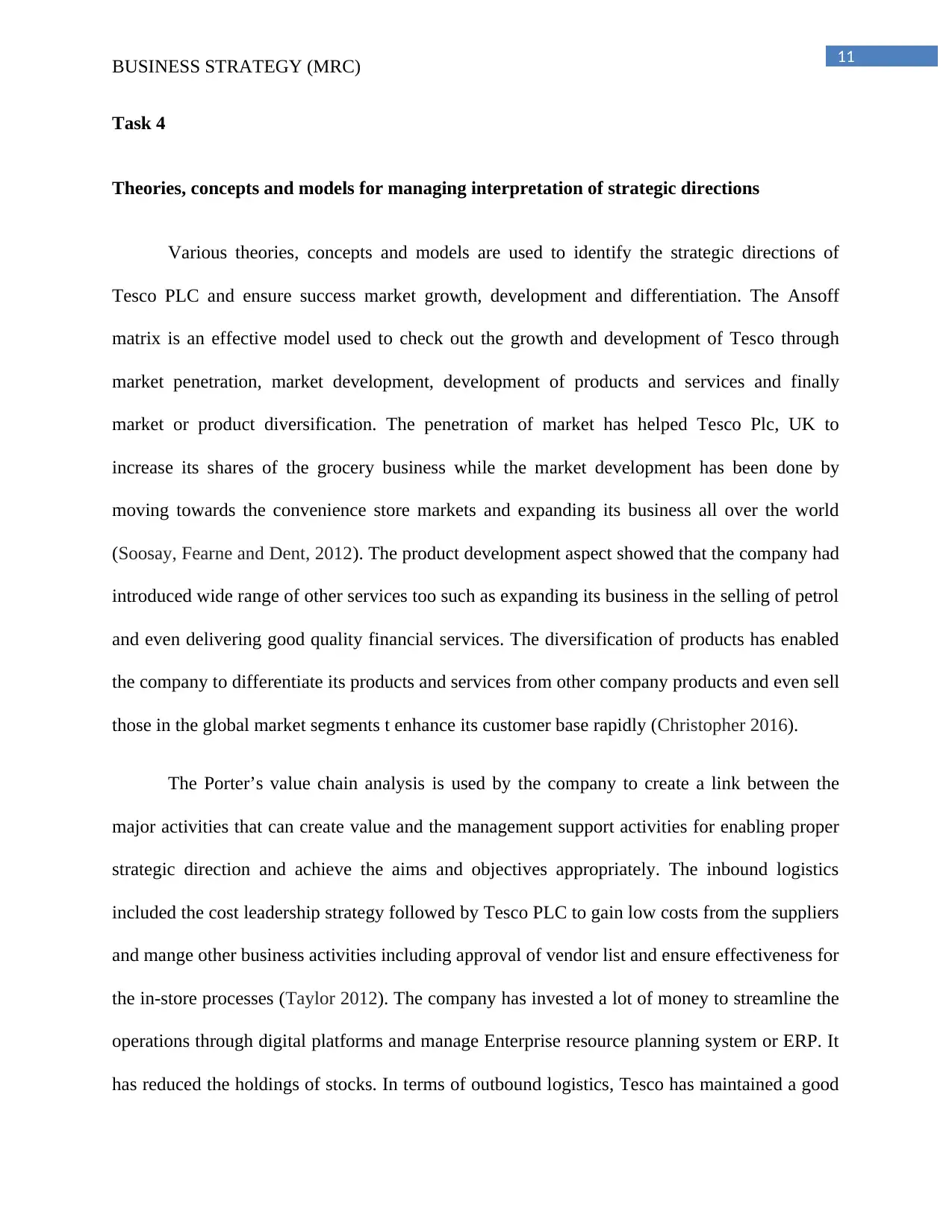
11
BUSINESS STRATEGY (MRC)
Task 4
Theories, concepts and models for managing interpretation of strategic directions
Various theories, concepts and models are used to identify the strategic directions of
Tesco PLC and ensure success market growth, development and differentiation. The Ansoff
matrix is an effective model used to check out the growth and development of Tesco through
market penetration, market development, development of products and services and finally
market or product diversification. The penetration of market has helped Tesco Plc, UK to
increase its shares of the grocery business while the market development has been done by
moving towards the convenience store markets and expanding its business all over the world
(Soosay, Fearne and Dent, 2012). The product development aspect showed that the company had
introduced wide range of other services too such as expanding its business in the selling of petrol
and even delivering good quality financial services. The diversification of products has enabled
the company to differentiate its products and services from other company products and even sell
those in the global market segments t enhance its customer base rapidly (Christopher 2016).
The Porter’s value chain analysis is used by the company to create a link between the
major activities that can create value and the management support activities for enabling proper
strategic direction and achieve the aims and objectives appropriately. The inbound logistics
included the cost leadership strategy followed by Tesco PLC to gain low costs from the suppliers
and mange other business activities including approval of vendor list and ensure effectiveness for
the in-store processes (Taylor 2012). The company has invested a lot of money to streamline the
operations through digital platforms and manage Enterprise resource planning system or ERP. It
has reduced the holdings of stocks. In terms of outbound logistics, Tesco has maintained a good
BUSINESS STRATEGY (MRC)
Task 4
Theories, concepts and models for managing interpretation of strategic directions
Various theories, concepts and models are used to identify the strategic directions of
Tesco PLC and ensure success market growth, development and differentiation. The Ansoff
matrix is an effective model used to check out the growth and development of Tesco through
market penetration, market development, development of products and services and finally
market or product diversification. The penetration of market has helped Tesco Plc, UK to
increase its shares of the grocery business while the market development has been done by
moving towards the convenience store markets and expanding its business all over the world
(Soosay, Fearne and Dent, 2012). The product development aspect showed that the company had
introduced wide range of other services too such as expanding its business in the selling of petrol
and even delivering good quality financial services. The diversification of products has enabled
the company to differentiate its products and services from other company products and even sell
those in the global market segments t enhance its customer base rapidly (Christopher 2016).
The Porter’s value chain analysis is used by the company to create a link between the
major activities that can create value and the management support activities for enabling proper
strategic direction and achieve the aims and objectives appropriately. The inbound logistics
included the cost leadership strategy followed by Tesco PLC to gain low costs from the suppliers
and mange other business activities including approval of vendor list and ensure effectiveness for
the in-store processes (Taylor 2012). The company has invested a lot of money to streamline the
operations through digital platforms and manage Enterprise resource planning system or ERP. It
has reduced the holdings of stocks. In terms of outbound logistics, Tesco has maintained a good
⊘ This is a preview!⊘
Do you want full access?
Subscribe today to unlock all pages.

Trusted by 1+ million students worldwide
1 out of 18
Related Documents
Your All-in-One AI-Powered Toolkit for Academic Success.
+13062052269
info@desklib.com
Available 24*7 on WhatsApp / Email
![[object Object]](/_next/static/media/star-bottom.7253800d.svg)
Unlock your academic potential
Copyright © 2020–2025 A2Z Services. All Rights Reserved. Developed and managed by ZUCOL.




